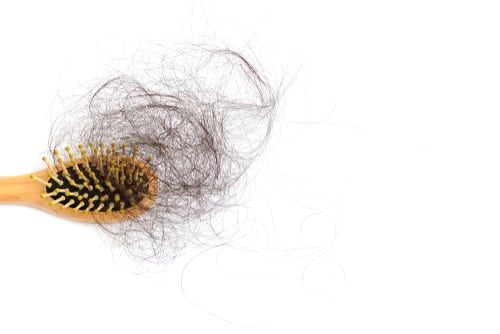Hair loss is medically known as alopecia. Everyone loses hair. It can be normal to lose about 50 to 100 strands of hair every day. There are also a number of medical conditions that may cause hair loss. Typically, when a patient comes to the Dermatologist with hair loss, extensive bloodworm is done to rule out systemic conditions. More than 20 diseases, including thyroid disease and anemia, cause hair loss. By treating the disease, hair loss is often stopped or reversed. In addition, significant hair loss can occur after a major surgery, an illness, high fever, or severe infection. Your dermatologist may refer to this type of hair loss as a telogen effluvium.
Infections of the skin like ring work of the scalp (tinea capitis) may also cause hair loss. This disease is contagious and common in children. Without effective treatment, ringworm can cause balding.
There are several different patterns of hair loss that we most commonly see and treat. First, Alopecia areata: Researchers believe that this is an autoimmune disease. Autoimmune means the body attacks itself. In this case, the body attacks its own hair. This causes smooth, round patches of hair loss on the scalp and other areas of the body. People with alopecia areata are often in excellent health. Most people see their hair re-grow. Dermatologists treat people with this disorder to help the hair re-grow more quickly usually with injectable corticosteroids. Second, Scarring alopecia: This rare disease develops in otherwise healthy people. The disease destroys a person’s hair follicles. Scar tissue forms where the follicles once were, so the hair cannot re-grow. Treatment tries to stop the inflammation, which destroys the hair follicles. Third, the most common cause of hair loss is a medical condition called hereditary hair loss. About 80 million men and women in the United States have this type of hair loss. Hereditary hair loss may also be known as male-pattern hair loss, female-pattern hair loss or androgenetic alopecia. When men have hereditary hair loss, they often develop a receding hairline. Many men see bald patches, especially on the top of the head. Women, on the other hand, tend to keep their hairline. They see diffuse noticeably thinning hair. The first sign of hair loss for many women is a widening part. In rare cases, men see noticeably thinning hair. And in rare cases, women can see a receding hairline or bald patches.
There are a number of treatment options available for hair loss. What is prescribed is dependent on the type of hair loss a patient is experiencing. Blood work and a physical examination will often give the diagnosis. But sometimes it is necessary to do a send a very small sample of the scalp and hair to the lab for a biopsy.
Hereditary Hair loss does tend to be the most common type of hair loss. The treatment options vary widely from topical prescription treatments to oral medicines include Propecia.
This year, the most recent research published in the Journal of Dermatology has shown exciting results with new supplements containing newly discovered ingredients that are stimulating the growth of new hair follicles. We have this new supplement available for purchase.
We also can provide innovative treatment with PRP to treat thinning hair and hair loss in men and women. Platelet Rich Plasma also is known as PRP is the process of taking one’s own blood, spinning it down to separate red blood from the platelets, and then producing a solution made up of a high concentration of growth factors to be injected or used topically on an individual’s skin. Platelets are responsible for clotting to prevent us from bleeding, repair injured skin, and stimulate our own body’s natural healing process. They are made of various growth factors that attract the correct types of stem cells to heal the area of injury.
PRP is most commonly used in Sports Medicine to improve joint articulation and degradation. Recently, PRP has been researched for other applications including skin rejuvenation and hair growth. The last approach, hair growth, PRP has shown tremendous promise when combined with our other clinical approaches to hair loss. In the case of alopecia, injecting high concentrations of your own growth factors back into the affected areas of the scalp helps to not only repair damaged skin in the scalp area but also aid in promoting increased follicle activity to achieve healthier and stronger hair follicles.
We use an FDA approved system for PRP to effectively and quickly remove all red blood cells (RBC) creating a solution to be injected in areas where hair loss and thinning has been determined. It is important to note that PRP done correctly, is not done in isolation. PRP is focused on making new stronger and healthier hair. Three treatments a month apart is necessary to see results. Then, one maintenance treatment may be needed in 6 months.
Side effects of PRP are uncommon, as no foreign substances or containment are used during the session. The most common side effect is redness and scalp irritation that can be also accompanied by an itching sensation. This also can occur during the time in which new hair follicles are formed.
To learn more about Platelet Rich Plasma (PRP) please call our office for an appointment.






